Planting Forced Paperwhites: Forcing Instructions For Paperwhites
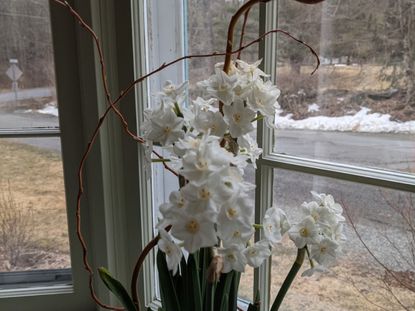
The dead of winter, when spring's arrival seems to be an eternity in coming, is a great time to figure out how to force paperwhite bulbs indoors. Paperwhite bulb forcing is an uplifting endeavor to undertake during an otherwise cold, dark season hearkening towards the light and warmth of spring to come. Forcing paperwhite bulbs will not only brighten the household but also elevate the occupant's mood. Paperwhite, or Narcissus, is one of the most foolproof flower bulbs to force. Planting forced paperwhites is so simple, the novice (or even your kids) can easily accomplish paperwhite bulb forcing. Many varieties of paperwhites are available, ranging from all white flowers to those composed of both light yellow and white.
Forcing Instructions for Paperwhites
Forcing instructions for paperwhites are relatively simple and are as follows:
How to Force Paperwhite Bulbs Indoors in Potting Soil
First, acquire excellent quality bulbs via mail order, local garden center, or even a florist for planting forced paperwhites in the fall, anytime after October 1st. Next, choose a container for forcing paperwhite bulbs. The container should hold at least 3 to 5 inches (8-13 cm.) of soil and have drainage holes. (A decorative pot or ceramic container without holes may be used when forcing bulbs in water and pebbles.) When paperwhite bulb forcing, use a well draining potting soil with a pH of 6 to 7 and any width pot; planting forced paperwhite bulbs with the tips even or slightly below the pot rim and 1 to 2 inches (2.5-5 cm.) apart. Set the pot of bulbs in a standing pan of water and allow to absorb the liquid for an hour or so and then remove and let drain. Paperwhite bulb forcing requires a cool temperature of around 50 to 60 degrees F. (10-15 C.) for two weeks and can then be moved into a warmer, sunnier area. Keep the soil consistently moist.
How to Force Paperwhite Bulbs Indoors in Pebbles and Water
When forcing paperwhite bulbs in water, select a pot or container without drainage holes anywhere from 3 to 5 inches (8-13 cm.) deep. Fill the container half full of clean pebbles, gravel, (up to ½ inch in diameter) or marbles and place the bulbs atop this material so that they almost touch. Gently surround the bulbs with additional material just to anchor them a bit and add water until it reaches the bottom (but not over as they may rot) of the bulbs. Place the container in a cool, dark location for two weeks and then move to a warmer, sunny area. Continue to replenish water as needed.
Planting Forced Paperwhites
Planting forced paperwhites every ten days will allow a continuing profusion of blooms throughout the entire winter season. Planting forced paperwhites in early fall may take longer to root than those planted in early February. When forcing paperwhite bulbs, it is helpful to label and date each planting to better ascertain when to plan the following year's schedule for planting. Forcing paperwhite bulbs takes longer in cooler temperatures, but will also allow the plant to bloom for a longer period of time. When forcing these bulbs, initially place in a 60 to 65 degree F. (15-18 C.) area and as they flower move to the coolest spot of the house. For best results, place them in a south exposure window and then again, as they begin to flower, move to a cooler area with indirect light. Easy to grow, but also delicate, planting paperwhite bulbs is a one-time shot-- usually. These plants are considered tropical, growing best in warm climates and treated as annuals in other areas. Once forced, the foliage will yellow and it is time to toss the bulb and soil, as planting paperwhites outdoors after forcing is rarely successful. If using pebbles or the like for forcing paperwhite bulbs, wash this medium and the containers thoroughly and store for the following year.
Gardening tips, videos, info and more delivered right to your inbox!
Sign up for the Gardening Know How newsletter today and receive a free download of our DIY eBook "Bring Your Garden Indoors: 13 DIY Projects For Fall And Winter".

Amy Grant has been gardening for 30 years and writing for 15. A professional chef and caterer, Amy's area of expertise is culinary gardening.
-
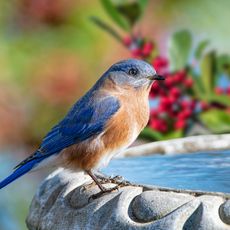 Gifts For Bird Lovers, Birders and Birdies To Attract More Feathered Friends To Your Yard!
Gifts For Bird Lovers, Birders and Birdies To Attract More Feathered Friends To Your Yard!If you’re looking to bring more birdies to your garden, these gifts for bird lovers should definitely be on your wish list. Grab some avian attractions to get your gardens all aflutter
By Janey Goulding
-
 Elegant Exotics: 8 Beautiful Amaryllis Varieties That Will Brighten Any Holiday Display
Elegant Exotics: 8 Beautiful Amaryllis Varieties That Will Brighten Any Holiday DisplayWhether red, pink, white or variegated, the right amaryllis varieties can enhance any living space, especially during the holidays. We round up eight of the most exquisite
By Bonnie L. Grant
-
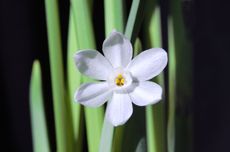 Can Paperwhite Flowers Rebloom: Tips On Getting Paperwhites To Rebloom
Can Paperwhite Flowers Rebloom: Tips On Getting Paperwhites To RebloomPaperwhites are common winter gift bulbs available year around. Getting paperwhites to rebloom after the first flowering is a tricky proposition. Some thoughts on how to get paperwhites to flower again follow in this article.
By Bonnie L. Grant
-
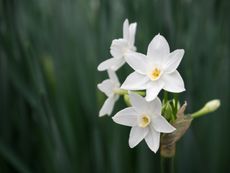 Growing Paperwhite: Tips On Planting Paperwhite Bulbs Outdoors
Growing Paperwhite: Tips On Planting Paperwhite Bulbs OutdoorsNarcissus paperwhite bulbs are classic holiday gifts that produce indoor blooms to brighten the winter doldrums. Planting paperwhite bulbs outside is still a fairly simple process. This article will help.
By Bonnie L. Grant
-
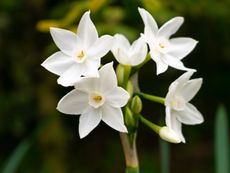 Germinating Paperwhite Seeds - Planting Paperwhites From Seed
Germinating Paperwhite Seeds - Planting Paperwhites From SeedThe Paperwhite Narcissus is an aromatic, easy-care plant with lovely white trumpet-like blooms. While most of these plants are grown from bulbs, it is possible to collect and plant their seeds. Find out how here.
By Nikki Tilley